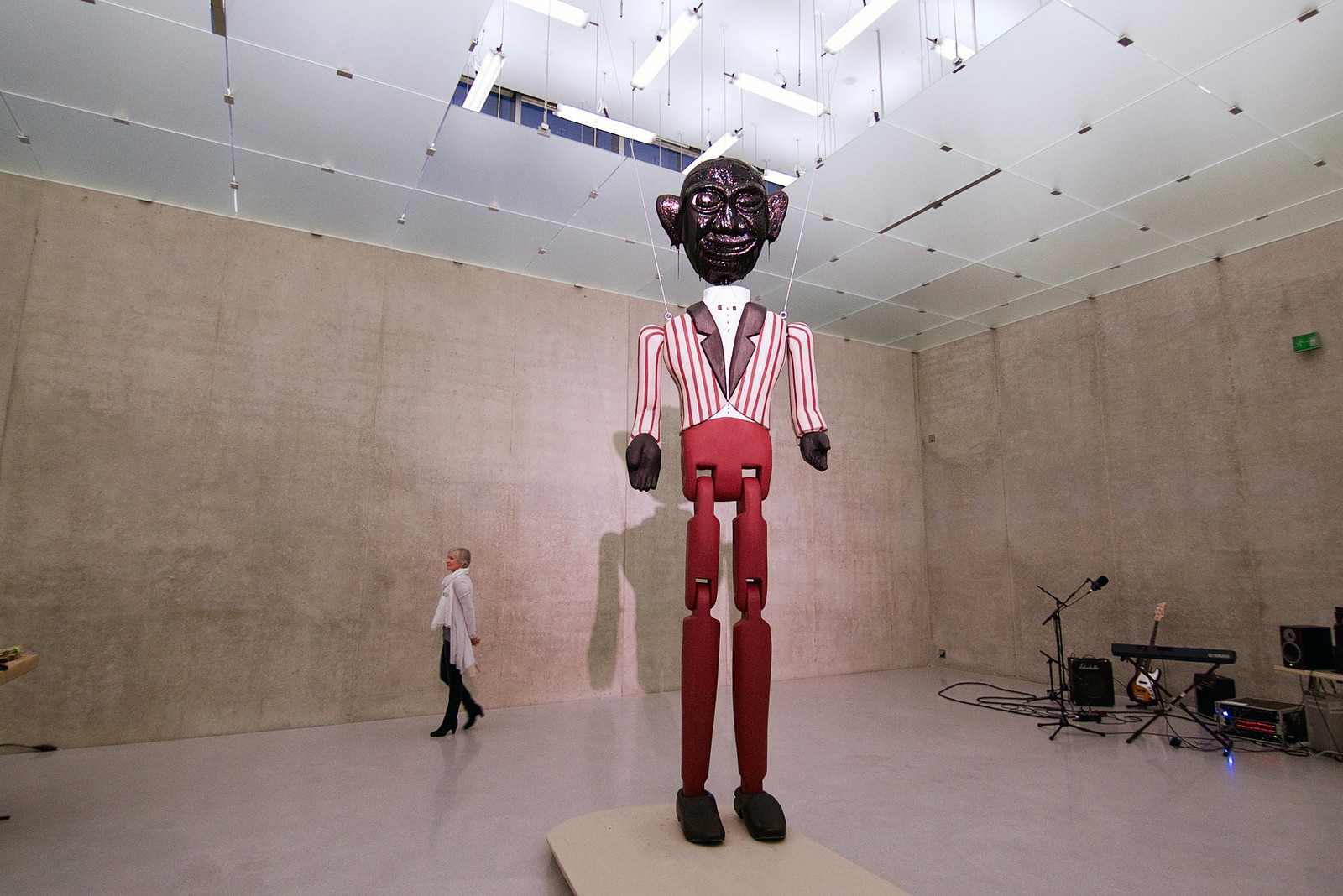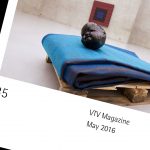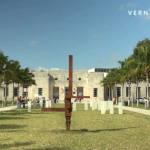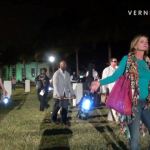Theaster Gates became known for the Dorchester Projects, a series of vacant buildings in Chicago that he renovated and rehabilitated with a team of young architects and designers, and which now offer space for performances, and other cultural events. Theaster Gates’ subject matter is construction and transformations, urban regeneration and the reversal of power relations. Black Archive at the Kunsthaus Bregenz in Bregenz, Austria, is Theaster Gates’ first institutional solo exhibition in Europe. In this video, we take a look at the exhibition on the occasion of the opening reception of the show.
Theaster Gates: Black Archive at Kunsthaus Bregenz in Bregenz, Austria. Vernissage, April 22, 2016.
> Right-click (Mac: ctrl-click) this link to download Quicktime video file.
Press text (excerpt):
“For as long as I can remember the everyday things of black people have had deep resonance for me. Looking at the collections of dresses in my mother’s closet, my father’s Florsheim shoes, my best friend’s collection of ski gear, my sister’s knives—all these things form my deep understanding of the importance of everyday things. Things that are special or things that are made special because we sharpen them, we shine them, we wrap them in plastic, we care for them, despite their ordinariness. This show for me, and this moment in my career, is about teasing out these moments that allow black things their rightful place in the world. I am honored that people would trust me, not only with their objects, but with the decades of gathering, deep contemplation, and time. It’s from this place of thankfulness and reverence that I start a more critical examination of how the world sees blackness and, by extension, how the world sees me.” Theaster Gates
The exhibition at Kunsthaus Bregenz is Theaster Gates’ first institutional solo exhibition in Europe. For several years he has been acquiring historical figures that depict Afro-Americans in a stereotypical manner. This collection of so-called “Negrobilia” portrays devoted servants, friendly mamas, and dancing slaves; with protruding lips, curly hair, and ample behinds. Gates is concerned with the gaze, together with projected and perceived identity. “For me, the collection serves as a reminder of a history and a catalyst for ongoing examination.”
A small baby doll too belongs to this collection which was begun by Edward J. Williams thirty years ago and later acquired by Theaster Gates, to remove the objects from public visibility and further circulation. This neckless figure, only a few centimeters high, is on display at Kunsthaus Bregenz as a hugely oversized work. The head, re-carved and painted black, lies on its cheek on a carpet covering the entire floor that has adopted the pattern of the embroidery. The original is in fact a pincushion. The pearls and gathered yellow ribbons have also been copied from the humiliatingly mawkish figure.
Additionally a video of a film from 1935 featuring Shirley Temple that Gates has re-edited, is being screened. The curly blonde haired child star received the Juvenile Award, an Oscar for child actors, at the age of six. In a famous scene from the film The Littlest Rebel, Uncle Billy, played by the black actor Bill “Bojangles” Robinson, dances on a flight of stairs, the white girl imitating his virtuoso footsteps. In another one they both tap dance on the street to earn money. The scenes are repeatedly interrupted by blackouts. It is an approach to questions of what being black means and the forms and associations that have been attributed and continue to be attributed to it by whites.
On the first floor Gates is showing a series of tar works incorporating unworked roofing materials. Theaster Gates has produced the majority of the works on display, specifically for the KUB exhibition and on site in Vorarlberg with the assistance of Tectum GmbH in Hohenems. The viscous material runs turgidly across their supports. Gates regards these works as “paintings about black people.” The images appear as gloomy icons and dark accusations. Liquid tar adheres the sometimes bulky forms to the support, the viscous mass oozing from the seams. A structure of parallel forms emerges. Aluminum foil and rubber sheeting are materials also used in roofing. They serve both as sealing and to protect against wind, weather, and heat. A number of small pictures from this series were also produced in Hohenems. These consist of squares coated with several layers of rubber and tar. The elastic material sometimes stretching beyond the picture’s limits, with traces of working, drips, rivulets, glued and abraded areas remaining visible. One of the collages shows the cover of Ebony magazine, likewise from Gates’ collection, a document of Afro-American life during the 1970s and 1980s.
An important aspect of Theaster Gates’ work is the conservation, transformation, and archiving of objects. As part of the exhibition historic issues of the Afro-American magazines Ebony and Jet will be bound live at the Kunsthaus Bregenz to become books, in collaboration with the Vorarlberg bookbinders Otto Hofer and Manfred Keckeisen. An a cappella concert by the artist at an event on April 23 at 2 p.m. will initiate the process. The murmuring bookbinders commenting on their work will be accompanied by a singing Gates.
On the second floor Theaster Gates has arranged sets of Jet magazines chronologically bound in various colors, into large squares. This is a series of works that has also been created in Bregenz. Jet magazines are small format magazines, a variant of Readers Digest for black readers. They provide a counter-image to the humiliating figures and portrayals of a culture and media industry dominated by whites. Gates collects them and has them bound in order to conserve them. Each color corresponds to a decade. The idea of arranging the books in reference to Josef Albers’ series of paintings Homage to the Square was one which developed spontaneously in Bregenz. Albers was a Bauhaus student, forced to flee in 1933 to the USA, becoming one of the most influential teachers at Black Mountain College.
In addition, a statue of St. Lawrence is on display on the second floor. The figure was rescued from an abandoned church, located next to Gates’ studio in Chicago.
Dancing Minstrel on the ground floor is a racist figure originating from 19th century burlesque revues. Gates has enlarged his own version to more than four meters high. The figure was fabricated by the Bregenz Forest woodcarver Wendelin Hammerer. It dangles from the ceiling. In order to see this interactive sculpture moving and dancing, the visitors themselves have to dance, setting the spring that balances it in motion. As a result both viewers and dancers find themselves on display in the role of an embarrassing and ridiculous idol.
Once more Theaster Gates succeeds in transporting a centuries long American subject into issues currently relevant to Europe.
Theaster Gates was born in 1973 in Chicago, where he lives and works. He has exhibited widely, including group shows such as Saltwater, 14th Istanbul Biennial (2015), the Whitney Biennial, New York (2010), dOCUMENTA (13), Kassel (2012), The Spirit of Utopia at the Whitechapel, London (2013), and Studio Museum’s When Stars Collide in New York (2014). In 2015 he was a participant in the Venice Biennale. Major solo exhibitions include To Speculate Darkly: Theaster Gates and Dave, the Slave Potter at Milwaukee Art Museum (2010), Theaster Gates: The Listening Room at Seattle Art Museum (2011/2012), and Theaster Gates: 13th Ballad at MCA Chicago (2013), as well as The Black Monastic residency at Museu Serralves, Porto (2014).
In 2013, Gates was awarded the inaugural Vera List Center Prize for Art and Politics, and in 2015 he won the Artes Mundi 6 Prize. Gates is also the founder of the non-profit Rebuild Foundation.
Since 2011 he has been the Director of Arts and Public Life at the University of Chicago and has been awarded an honorary doctorate by the San Francisco Art Institute.
Photos:








